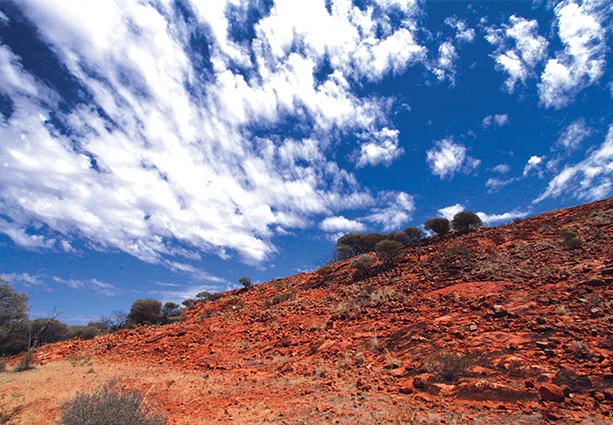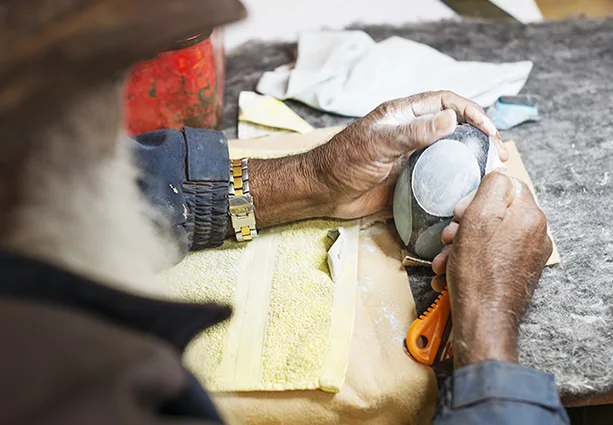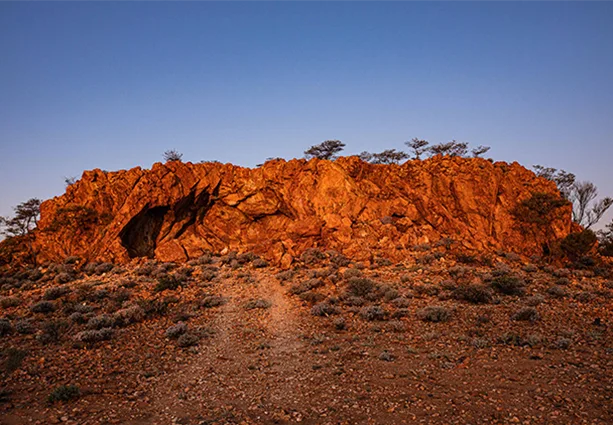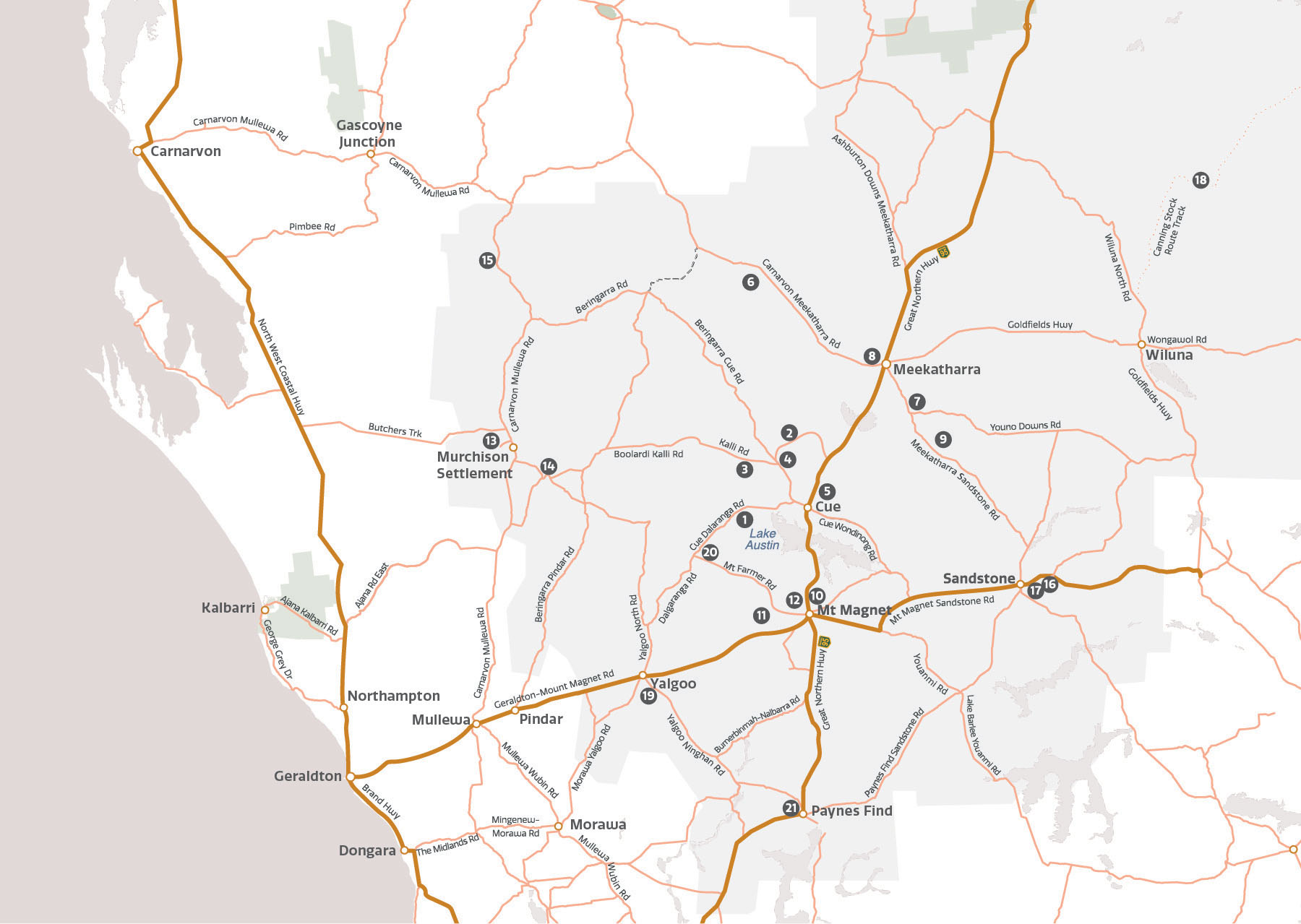While you are here
Discover the spectacular Murchison GeoRegion
Need more information about what there is to do in the region? Ask a local!
The towns in the Murchison GeoRegion all have unique attractions and things to see and do. Call in to a local Visitor Information Centres to find out more and make sure you set aside some time for star gazing!
Download our trail guide for detailed information about each town and the Murchison GeoRegion sites within each area.


Cue
Known as the ‘Queen of the Murchison’ due to its importance in gold production, Cue’s dark red backdrop has amazing heritage assets, rich biodiversity, Aboriginal culture and attractions.
Cue was named after a prospector who registered the first gold claim in 1892 but the first gold discovery was by an Aboriginal prospector named Governor. Soon after the first claim a reef of gold was found in Day Dawn, however, all that remains is the Great Fingal Mine Office on the edge of the open cut.
The Cue Heritage Trail retraces the early development of the district and includes many of the town’s heritage buildings, including the Cue Courthouse, Police Station and Bell’s Emporium which are still being used for their original purpose.
Learn more about the history of the area at the Cue Heritage Discovery Centre from the Shire of Cue.
Meekatharra
Meekatharra is a golden prospect for visitors to the Murchison GeoRegion, with the gold mining riches of yesteryear leaving a rich legacy for the town and the region. Explore the rocky outcrops, look for native animals and experience the glorious display of colourful wildflowers which bring Meekatharra to life in winter and spring.
Originally a gold prospecting town first settled in 1896, the area around Meekatharra is rich in history and culture. Take some time to explore the Meeka Discovery Trail which winds around the town and includes a lookout where you can see a ‘superpit’ mine and the township.
Open on weekdays, the Meekatharra Museum contains over 100 photographs and memorabilia of life through the years.
Explore the Meeka Heritage Trail and State Battery, discover some local art or call into the Visitor Centre to find out where you can search for your next gold find!


Mount Magnet
Mount Magnet is the oldest continuous gold mining centre in Western Australia and has an ancient geological and rich cultural history that is at the heart of the town’s story.
The Heritage Walk is a leisurely stroll through town and with its wide roads and old shop fronts, has a feeling of days gone by. You’ll pass the Old School House, Post Office and Residence, Outdoor Picture Theatre and public art.
Immerse yourself in the Mining and Pastoral Museum and its vast collection from the town’s rich past that provides an insight into early pastoral and gold mining activities. You’ll also see the rebuilt Boogardie State Battery and an outstanding Rabbit Proof Fence story and film set exhibit.
The Wirnda Barna Art Centre showcases artworks depicting the rich landscape and important cultural sites in the area by Aboriginal artists from Mount Magnet and the surrounding region.
Murchison
The Shire’s tagline, ‘Ancient Land Under Brilliant Skies’ captures the essence of the Murchison perfectly. It is home to sprawling pastoral stations, spectacular wildflower displays, rugged breakaways and cool river pools. Also, the Murchison Radio Observatory is the Australian home of the international science project, the Square Kilometre Array.
The cooler months are the perfect time to explore the rangeland Botanical Walk, go bird watching, take in the amazing night sky or enjoy a barbecue picnic at the restored stock well 55kms south of the Settlement.
Visit the Murchison Museum, constructed from rammed earth in the mid-1980s. The museum collects, preserves, and houses a fascinating display of historical items, as well as an herbarium of rangeland plant species.
If you’re lucky enough to time your visit with the annual polocrosse event, you’re in for a treat with clubs travelling from across the state to attend.


Sandstone
Sandstone is a brilliant location for stargazing and spectacular sunsets. Now a centre for the region’s mining and pastoral industries, the wide streets and historic buildings of Sandstone are a reminder of its heyday following a major gold discovery in 1894.
Built in the 1940s, The Sandstone Heritage Museum was once a grocery store but now houses a collection of photographs and items portraying life in Sandstone at the turn of the 20th century. A short walk from the Museum is The Heritage Cottage built in 1923 by a local pastoralist and furnished to reflect that era.
Pick up a brochure for the Sandstone Heritage Trail and explore the township’s heritage buildings, several of which have been restored, including the Post and Telegraph Office, Warden’s Court and Black Range Chapel.
Play a round on the 18-hole golf course (clubs are available for hire from the Visitor Centre), cool off at the Water Park or try your luck gold prospecting before a sunset picnic.
Wiluna
Sitting on the edge of the Western Desert, Wiluna is the gateway to the Canning Stock Route and the Gunbarrel Highway.
The best way to explore the heritage of Wiluna is to follow the Town Heritage Trail which takes you on a fascinating journey to 30 places of interest, with many stories about local characters that once lived there.
Visit the Tjurkurba Art Gallery, for an opportunity to meet and chat with local Aboriginal artists and view original artworks which embody a rich culture of country, history and lifestyle.
Learn the story of Australia’s last desert nomads, Warri and Yatungka who lead a traditional lifestyle in the Gibson Desert until 1977. A statue at the town’s entrance commemorates their life.
Drop into the Discovery Centre, located in the old Wiluna Hospital to learn about more about the fascinating history of Wiluna, the Canning Stock Route and Gunbarrel Highway.


Yalgoo
Yalgoo – where the outback begins and an ideal place to start (or finish) your Murchison GeoRegion adventure, particularly during the wildflower season. Founded in the 1890s, Yalgoo has plenty of reminders of the town’s wild gold rush days, which can be relived at the Court House Museum, showcasing over 80 years of history through old photographs and artefacts.
Wildflower season changes the dramatic landscape into a carpet of colour between July and September, and the Karara Rangeland Park is one of the many places you can experience this. Camping is allowed through Park Stay WA (fees apply).
Explore the Yalgoo Heritage Trail, a self-guided walk/drive through the town giving you a glimpse of the town’s past, colonial architecture and a chance to see the Dominican Chapel, one of the most interesting and unusual buildings constructed by architect and priest, Monsignor John Hawes in 1922.


